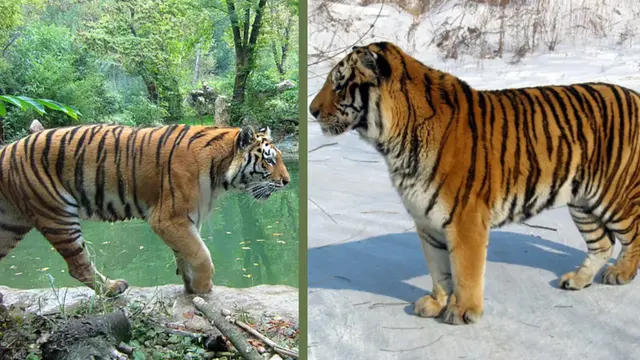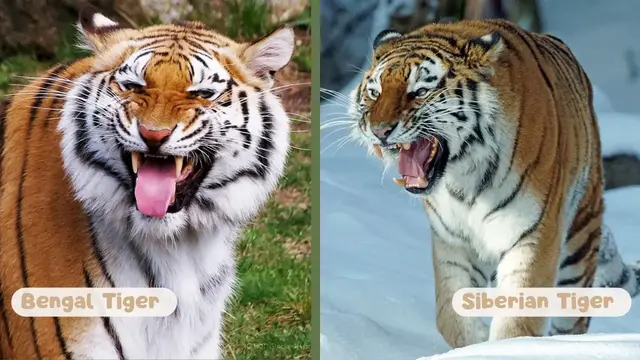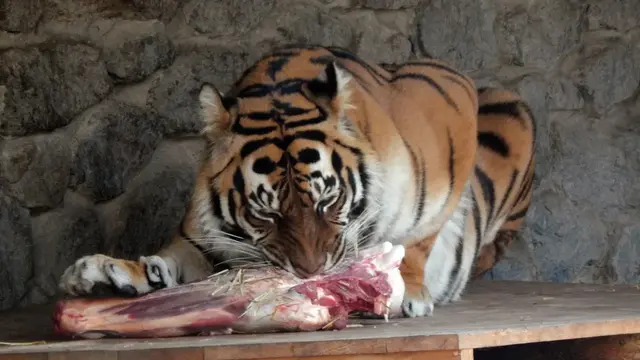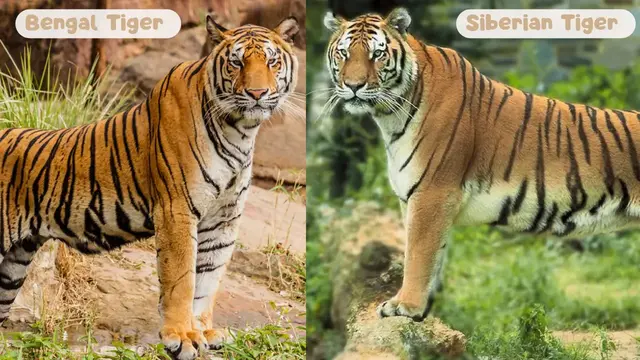Table of Contents
Introduction
Siberian tigers and Bengal tigers are two of the royal and amazing big cats in the world. It is important to understand the differences between these Siberian tiger vs Bengal tiger subspecies for raising their unique variation and the challenges they face in the wild. In this article we tell you about Siberian and Bengal tiger’s physical characteristics, geographical distribution, nature behavior, diet, reproduction, conservation status, and cultural significance. We tell you complete differences to help wildlife lovers and conservationists similarly.
Geographical Distribution

Natural Habitats of Siberian Tigers
Siberian tigers are also identified as Amur tigers and mostly live in the Russian Far East which is situated with some population in China and North Korea. Their habitat consists of the mountainous regions and boreal forest where they can cross large territories.
Natural Habitat of Bengal Tigers
Bengal tigers mostly live in the subcontinent India, Bangladesh, Bhutan, and Nepal. Their habitat is in many environments, from the mangrove wetland of the Sundarbans to the dark grasslands and forests.
Overlap in Distribution
There is small to no geographical overlap among the habitats of Siberian and Bengal tigers due to the huge differences in their environmental needs and the distance among their native regions.
Physical Characteristics
Size Comparison
Siberian tigers are mostly bigger than Bengal, including males that are averaging 10-12 feet long with tail and weight between 400-600 pounds. Bengal are slightly small and still tough, averaging 9-10 feet lengthy including males and around 400-550 pounds in weight.
Fur Color and Pattern Differences
Siberian tigers have a thick and paler coat that gives them insulation against the severe cold of their environment. Their stripes marking are far and widely spaced compared to Bengal tiger’s stripes, which have a shinier orange coat with closely spaced black stripes pattern, suitable to the thick jungles they inhabit.
Unique Physical Traits
Siberian tigers have bigger hands and a thick layer of fat to help them cross and survive the cold. On the other hand Bengal tigers have more pronounced face markings and a more simplified body for moving through thick planted areas.
Behavioral Differences

Hunting Techniques
Siberian tigers hunt large ungulates, for example deer and wild pig, using their power and stealth to trap targets. Bengal tigers have a more diverse diet, such as smaller animals like birds and fish, to add large targets.
Social Structure
Siberian and Bengal both tiger subspecies are commonly unsocial, but Bengal tigers have been detected with little social interactions. Especially in the breeding periods and when female’s tigresses are raising cubs.
Territory Range
Siberian tigers have bigger territories due to spare availability of targets in their surroundings, sometimes they cover up to 1000 square kilometers. Bengal tigers have small territories around 100 square kilometers on average, because of higher availability of prey in their habitats.
Are Horses and Zebras the Same Species?
Diet and Prey

Common Prey for Siberian Tigers
Siberian subspecies commonly target large animals like elk, deer and wild pig. They sometimes hunt small animals and birds but their big size needs a large amount of meat to sustain them.
Common Prey for Bengal Tigers
Bengal subspecies have a various diet such as deer, wild pig, buffalo, and also small animals like monkeys and peafowl. Their flexibility in diet is a main factor in their survival across many habitats.
Adaptations for Hunting
Siberian subspecies are made for stamina and strength, which allow them to take down large targets in the snowy land. Bengal subspecies are more active and silent, skilled at following and trap prey in thick forest.
Reproduction and Lifespan
Mating Behavior
Siberian and Bengal both tigers have the same mating behaviors, with males and females coming together only for the purpose of breeding. Females signal their readiness through track marking and tiger voices.
Cub Rearing
Female tigers of both Siberian and Bengal subspecies raise their cubs alone, teaching them to hunt and survive till their age getting two years old. The survival rate of cubs is comparatively low because of many threats, also with predation and competition.
Lifespan in the Wild and Captivity
Siberian and Bengal subspecies live around 10-15 years in the wild, with some singles reaching up to 20 years in captivity because of the absence of threats and availability of daily food and medical care.
Conservation Status
Current Population Estimates
Siberian tigers are estimated to have a population of around 500 singles in the wild. Bengal subspecies have a larger population than Serbian subspecies which are estimated around 2500 singles. Serbian and Bengal tiger populations are classified as rare because of habitat loss and poaching.
Threats to Their Survival
Major threats to both Siberian and Bengal subspecies contain habitat destruction, stealing for their pelts and body parts, and human wildlife conflict. Siberian subspecies face extra challenges because of the harsh climate and lower prey density in their homes.
Conservation Efforts and Success Stories
Many conservation programs have been executed to protect these tigers, with anti-poaching patrols, homes restoration projects, and mating programs in captivity. Success stories with the stabilization of Siberian tiger populations in Russia and growth of Bengal tiger numbers in India because of dedicated conservation efforts.
Cultural Significance
Role in Local Folklore and Mythology
Tigers hold a projecting place in the folklore and mythology of the region where they inhabit. Siberian subspecies are valued in Russian and Korean cultures as a sign of power and strength. Bengal subspecies are extremely embedded in Indian mythology and are often portrayed in local art and stories as powerful and protective beings.
Representation in Media and Literature
Siberian and Bengal subspecies both have been famous subjects in literature, documentations, and films, highlighting their dignity and the challenges they face. Iconic symbols with Rudyard Kipling’s “The Jungle Book” and many wildlife documentaries showcasing their natural character and conversation.
Symbolism and Importance in Various Cultures
Tigers signify power, courage, and beauty in many cultures. They are often used as national signs for example the Bengal tiger being the national animal of India and Bangladesh, reflecting their importance and the need for their protection.
Interaction with Humans
Human Tiger Conflict
Human violation into tiger habitats often leads to conflicts, with tigers attacking livestock or humans in rare cases. Efforts to alleviate these conflicts with the creation of buffer zones and community education programs.
Eco Tourism and Tiger Reserves
Eco tourism has become an important source of funding for tiger conservation. Tiger reserves in India and Russia attract tourists from around the world, giving economic benefits to local communities and raising awareness about the importance of tiger conservation.
Conservation Education and Awareness
Education programs expected at local communities and broader peoples play an important role in tiger conservation. These programs emphasize on the importance of tigers in the environment, the threats and fears they face, and ways to coexist peacefully.
Expert Insights
Quotes from Wildlife Biologists
“Understanding the differences between Siberian and Bengal subspecies is crucial for developing effective conservation strategies tailored to their unique needs.” – Dr. John Smith, Wildlife Biologist.
Insights from Conservationists
“Both subspecies face significant threats, but with concerted efforts from governments, NGOs, and local communities, we can ensure their survival for future generations.” – Jane Doe, Conservationist.
Opinions from Local Communities
“Tigers are an integral part of our culture and heritage. Protecting them is not just about conserving wildlife but also preserving our identity.” – Local Community Leader.
Conclusion
Siberian tigers and Bengal subspecies share various similarities which are unique in their variations and the challenges they face. Conservation efforts are energetic to their survival, and it is up to us to make sure that these wonderful creatures remain to grow in the wild. By supporting conservation creativities, spreading awareness, and endorsing maintainable practices. We can make a difference in the flight to save these iconic animals.
Frequently Asked Questions
Q. What are the main differences between Siberian and Bengal tigers?
A. Siberian tigers are generally slightly big with thick coats, which are adapted for cold climates. Bengal tigers have a more shiny color coat with closely black stripes design, suitable for thick jungles.
Q. Where do Siberian and Bengal tigers live?
A. Siberian tigers originate in the Russian Far East and some populations in China and North Korea. Bengal tigers are habitat in the Indian subcontinent including India, Bangladesh, Bhutan, and Nepal.
Q. Which is bigger, a Siberian or a Bengal tiger?
A. Siberian tigers are generally large, averaging 10-12 feet in length and 400-600 pounds in weight. Bengal males are average 9-10 feet in length and 400-500 pounds in weight.
Q. What do Siberian tigers eat compared to Bengal?
A. Siberian mostly hunt big animals such as deer and wild pigs. Bengal have a various types of diet for example deer, wild pig, buffalo, and small animals and birds.
Q. How long do Siberian and Bengal tigers live?
A. Siberian and Bengal tigers both live around 10-15 years in the wild. In captivity, they can live up to 20 years because of better care and the absence of threats.
